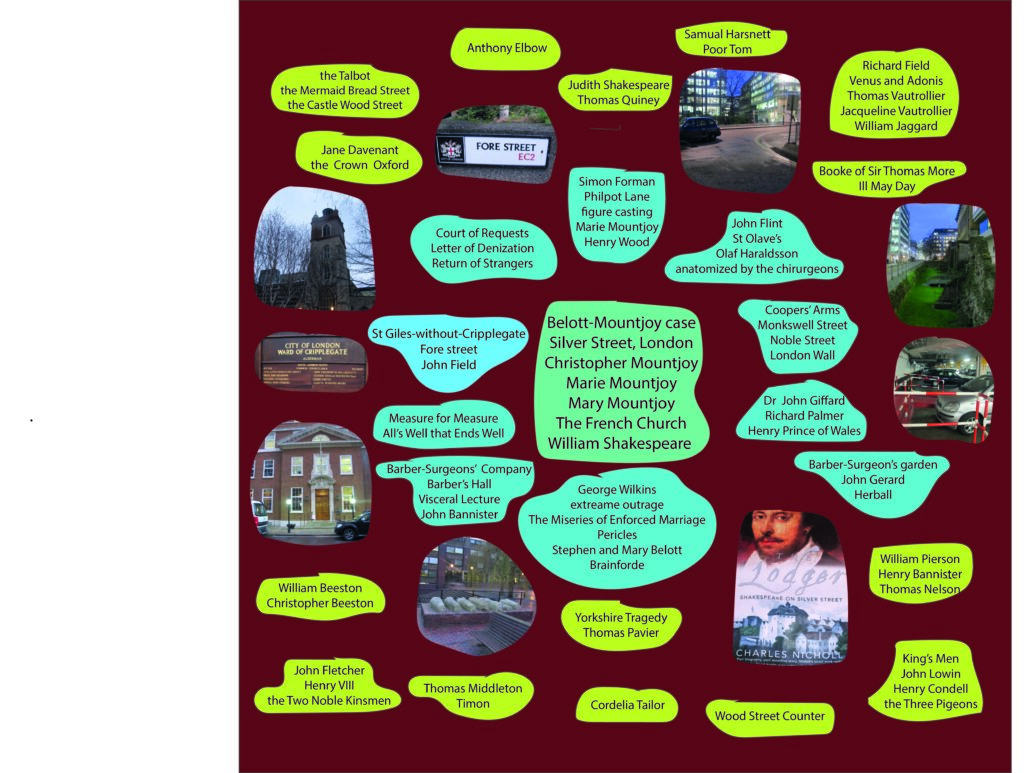Perhaps it is better said that it is worthwhile to read books and especially rewarding to discover treasures among them. An example of this is the book entitled ‘The Lodger’ by Charles Nicoll whose starting point was the serendipitous discovery of a part of a court record involving William Shakespeare. The record related to a time when Shakespeare was a lodger with the Mountjoys – a Hugenot family in Silver Street in the Cripplegate district of London. A point of dispute had arisen when it was alleged that a promised dowry of Mary Mountjoy had not been honoured. This was the basis of the so-called Belott-Mountjoy case heard by the Court of Requests. Shakespeare’s testimony as a verbatim account of his evidence was hardly supportive of the legal action. More than likely he would have been annoyed at having to take time out to provide his evidence. By meticulously researching every possible detail of the locality of what was Silver Street, the author, succeeds in drawing together fascinating details of local life that would have been known to Shakespeare.
The opportunity arose to ‘walk the walk’ in the district that had been Silver Street after attending a meeting in a nearly conference centre. A photographic record of landmarks was undertaken using a trusty Canon compact camera. Various of the enduring landmarks such as Cripplegate Church and Surgeon’s Hall were duely captured. Cripplegate Church is perhaps the only building in the locality to have survived the Great Fire of London, the Blitz and last but not least- the property developer. The present day Surgeon’s Hall is built near the site of the original Barber’s Hall that was active in Shakespeare’s time. The building’s role today is more akin to a community centre and where on the day I chanced upon it, flu vaccines were being offered. The archivist, however, was not on duty to answer various questions. It was in the original Barber’s Hall that the so called ‘visceral lecture’ was given – being a public dissection of a cadaver. Such lectures were often given by John Banister – a well known ‘anatomist’ of the era and where the dissected remains were subsequently interred in St Olave’s churchyard. St Olave’s would have been the church that Shakespeare attended when in residence in Silver Street. While the church has not survived, vestiges of the churchyard remain though it escaped my searches on the day of my visit. A feature of the original Barber’s Hall had been the Barber-Surgeon’s Garden where a wide range of herbs were grown for medicinal applications.
Numerous associates of Shakespeare are mentioned in the Nicholl’s book based on association with active literary and acting circles. The name particularly of John Fletcher springs to mind as the playwright who continued, as it were, Shakespeare’s contract with the Kings Men players after Shakespeare’s death in 1616. It is likely, also, that John Fletcher provided creative assistance to Shakespeare in the plays Henry VIII and Two Noble Kinsmen. The name of John Field also finds reference, being a printer who published various of Shakespeare’s poems including Venus and Adonis. The probably knew each other well in London since they had grown up together in Stratford-on-Avon. The name of George Wilkins also surfaces within the narrative, where records of Wilkins appears through various court records for what could be described as violent and disorderly conduct – and often against women. While Wilkins is credited with various minor works, it is credible that he co-operated with Shakespeare in the writing of Perecles – Prince of Tyre. The name of Jane Davenant also emerges as a possible romantic involvement with Shakespeare linked with the Crown Public House in Oxford.
The ‘Wood Street Counter’ is also referenced- being the local debtor’s prison where its odious smell would have given warning of the deprivations of those within its walls. This perhaps gives an insight into the then attitudes of Tudor England to debt. An enduring structure on the much altered landscape around Silver Street is the London Wall, constructed initially by the Romans to define the boundaries of the settlement. A fort was initially constructed around Cripplegate in the northwest corner of the wall and sections of the wall can still be seen to this day. The actual site of the Mountjoy dwelling is now an underground car park. It could have been an interesting exercise to have built a restored dwelling on the site – but who can prevail against the march of progress.
Based on the photographic record and the narrative of ‘The Lodger’, a collage of text and cropped images has been constructed – see attached. Tap the text into Google to find out more. History does fortunately leave its traces.
